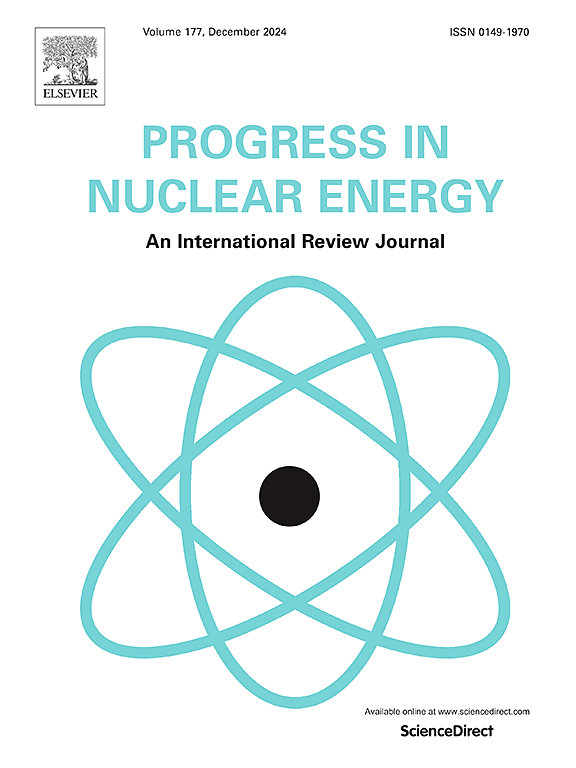确定性和概率深度学习在脉冲驱动亚临界系统反应堆物理预测中的应用
IF 3.2
3区 工程技术
Q1 NUCLEAR SCIENCE & TECHNOLOGY
引用次数: 0
摘要
广泛报道了当亚临界组件(SCA)远离临界时,标准技术在反应性测量中的不理想响应。这源于点反应堆动力学中基模假设的松散适用性,由此导出了有关探测器响应与反应性的解析公式。这项工作评估了深度学习(DL)在克服这些偏倚效应方面的潜力,特别是在脉冲中子源(PNS)驱动的SCA中。利用中子计算数据训练了处理核心图和探测器时间响应的确定性DL模型,并在模拟PNS实验中与Area-ratio和Slope-fit方法进行了比较。结果表明,深度学习对空间效应具有鲁棒性,严重影响面积比方法导致严重低估,是临界安全的非保守情景。例如,keffDL=0.94158近似等于keffMCNP=0.94093±0.00034;与此同时keffArea−比率= 0.435±0.00900≪keffMCNP。此外,与斜率拟合方法不同,DL并没有表明随着系统变得深度亚临界,偏差会增加。这些优势也扩展到基于贝叶斯神经网络的概率变量,由于匹配预测和观察到的置信度,这些概率变量被发现可以很好地校准。这些发现表明,在操作环境中部署DL的巨大潜力,有助于确保sca的安全边际和研究堆的安全临界方法。本文章由计算机程序翻译,如有差异,请以英文原文为准。
Deterministic and probabilistic Deep Learning in predicting reactor physics of subcritical system driven by a pulsed source
Widely reported are the non-ideal response of standard techniques in reactivity measurement when the Subcritical Assembly (SCA) is far from critical. This emanates from the loose applicability of fundamental mode assumption in Point Reactor Kinetics from which the analytical formulae relating detector response to reactivity were derived. This work evaluated the potential of Deep Learning (DL) in overcoming these biasing effects particularly in an SCA driven by a Pulsed Neutron Source (PNS). Deterministic DL models processing core map and detector temporal response were trained using data from neutronics calculations, and subsequently compared with Area-ratio, and Slope-fit methods in a simulated PNS experiment. Results show the robustness of DL against spatial effect that severely affected Area-ratio method leading to severe underestimation, a non-conservative scenario in criticality safety. As illustration, is approximately equal to ; meanwhile . Furthermore, DL did not indicate increasing bias as system becomes deeply subcritical unlike Slope-fit method. These advantages also extended to probabilistic variants based on Bayesian Neural Networks, which were found to be well-calibrated due to matching predicted and observed confidence levels. These findings suggest the strong potential of deploying DL in an operational context, helping assure safety margins in SCAs and safe approach to criticality in research reactors.
求助全文
通过发布文献求助,成功后即可免费获取论文全文。
去求助
来源期刊

Progress in Nuclear Energy
工程技术-核科学技术
CiteScore
5.30
自引率
14.80%
发文量
331
审稿时长
3.5 months
期刊介绍:
Progress in Nuclear Energy is an international review journal covering all aspects of nuclear science and engineering. In keeping with the maturity of nuclear power, articles on safety, siting and environmental problems are encouraged, as are those associated with economics and fuel management. However, basic physics and engineering will remain an important aspect of the editorial policy. Articles published are either of a review nature or present new material in more depth. They are aimed at researchers and technically-oriented managers working in the nuclear energy field.
Please note the following:
1) PNE seeks high quality research papers which are medium to long in length. Short research papers should be submitted to the journal Annals in Nuclear Energy.
2) PNE reserves the right to reject papers which are based solely on routine application of computer codes used to produce reactor designs or explain existing reactor phenomena. Such papers, although worthy, are best left as laboratory reports whereas Progress in Nuclear Energy seeks papers of originality, which are archival in nature, in the fields of mathematical and experimental nuclear technology, including fission, fusion (blanket physics, radiation damage), safety, materials aspects, economics, etc.
3) Review papers, which may occasionally be invited, are particularly sought by the journal in these fields.
 求助内容:
求助内容: 应助结果提醒方式:
应助结果提醒方式:


